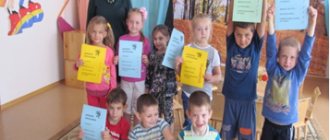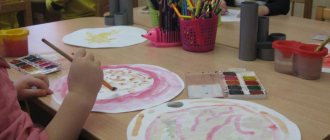MAGAZINE Preschooler.RF
“Labor education of children in the middle group of kindergarten”Target:
Formation of a positive attitude towards work in children 4-5 years of age.
Tasks:
- Cultivate a desire to work.
- Learn to carry out individual and collective assignments, develop the ability to negotiate with the help of a teacher about the distribution of work, and take care of the timely completion of a joint task.
- To instill in children independence, accuracy, mutual assistance, caring for each other and responsibility for a common cause.
- Explain to children the importance of their work.
- Encourage initiative in helping friends and adults.
- Learn to finish what you start.
Types of work of preschool children:
- Self-service.
- Household work.
- Labor in nature.
- Manual labor.
Forms of labor organization:
- Errands.
- Duty roster.
- Collective work (common, joint).
Labor education is an important means of comprehensive development of the personality of a preschooler. The main goal of work is its educational influence on the child’s personality. Work also has a significant impact on the mental development of a child. It requires intelligence, initiative, concentration, and trains memory. In the process of work, adults give children useful knowledge about objects, materials and tools, their purpose and use.
Children in the middle group of kindergarten are characterized by elementary household work - self-service, associated mainly with satisfying their personal needs. Children must master such actions and operations of household activities as: setting the table for lunch, breakfast or afternoon tea, preparing materials for classes, maintaining order in the room and area.
In the middle group, in addition to consolidating previously learned skills, work is being done to develop more complex self-care skills. The children are given the task of providing mutual assistance when getting dressed: tying a scarf, teaching how to tie shoes, helping the baby get dressed, etc.
In the middle group, the content of household labor becomes more complicated mainly due to an increase in the number of processes of this labor. So, at the beginning, under the supervision of a teacher, and by the end of the year, children independently maintain order in the group and in the area, take part in cleaning (wipe shelves, wash toys, etc.). In this age group, children master the integral processes of household labor (washing doll clothes, washing toys, setting the table). This requires children to know specific techniques and operations, and to be able to use them in the right sequence.
You can cultivate in children the ability and desire to work through the organization of work activities:
- Orders
- Joint activities of children with the teacher.
- Responsible for cafeteria and classes.
Assignments are the simplest form of organizing the work activities of preschool children. Errands are widely used in all age groups of kindergarten
In the practice of educational work with children, individual assignments are especially common, less often collective ones, to small subgroups of 2-3 people. Since it is much easier to teach one or two children than a whole group, and monitoring the actions of everyone is more convenient.
Duty duty is a more complex form of organizing children’s work. They require more independence from the child. The attendants learn to carry out the assigned task completely; this requires children to know the sequence of necessary actions.
The volume of tasks for labor education increases from the middle group, reaching a maximum in the senior group. It is in the middle group that children actively master various work skills and techniques of working in nature, household and self-service work.
In the process of labor, children acquire the necessary skills, including the skills of caring for plants and animals (labor in nature), master the simplest operations with objects, learn about materials and their properties (manual labor). Children develop an interest in work and a desire to work (household work, self-service).
| Next > |
Middle group. Junior preschool age. Children 4 - 5 years old
Summary of educational activities “All works are good” for children 4–5 years old Synopsis of OD Cognitive development (development of cognitive and research Topic: “All works are good”
Goal: expand children’s understanding of
professions , cultivate respect for people of different professions . Equipment: pictures depicting people of different professions , color...
Lesson “Be kind to those who depend on you” for children 4–5 years old Goal. Expand and deepen children's knowledge about living nature. Promote the harmonious development of the child’s personality. Objectives: to develop the relationship between man and nature. Promote understanding of compassion for animals. Cultivate attentiveness , responsiveness, gratitude,...
An article about introducing middle school children to the challenges of adulthood
Familiarization with the work of adults in the middle group.
In the middle group, work to familiarize adults with labor and cultivate a positive attitude towards workers continues. Work to familiarize adults with the work in their immediate environment must be continued. Children of this age are already more independent, they have more developed powers of observation and therefore have a richer understanding of the work of kindergarten staff (music worker, teacher, assistant teacher, nurse, laundress, cook, choreographer , physical education teacher, etc...) In addition, when familiarizing yourself with the work of a junior teacher, laundress, cook, janitor and other kindergarten employees, attention is paid to the formation of ideas about the content and structure of the processes of household labor of adults in a preschool institution (table setting, washing utensils, processes ensuring the maintenance of cleanliness and order in the group room and area; washing clothes; cooking, etc.).
Children should be introduced to professions that are understandable to them (salesman, hairdresser, driver, builder, doctor), but children 4–5 years old have more advanced work skills compared to children, their feelings and relationships are more conscious, and their interest in the life around them is broader. All this allows us to somewhat change the nature of pedagogical work, not only in content, but also in form. With children of the middle group, it is necessary to introduce excursions to familiarize themselves with the professions of adults, and in the second half of the school year, children of the middle group, when getting acquainted with the work of a cook, are introduced to the simplest processes of food preparation: vinaigrette, pancakes, cutlets. It is necessary to note that to prepare different dishes, the chef uses different tools and products, and cooks in different ways. Knowledge about the labor processes of cooking is reinforced in didactic games. You can use photographs depicting the work of the cook (5-6). An idea is given of the structure of the labor process, the relationship of its components using the example of specific labor processes (the purpose of labor determines what objects, materials and tools need to be taken to perform labor actions and obtain a result that corresponds to its purpose).
Several new topics are being developed: “About how our mothers and fathers work,” “Who works on the collective farm,” “About the work of people in transport professions,” “About the work of builders.” The teacher tells the children about the content of work and its social significance. However, a story about professions becomes pedagogically valuable when, explaining the content of work, the teacher focuses not on the specification of the process, but on the person, his business and personal qualities, that is, directly or through fiction, he introduces children to the person
a certain profession. At the same time, attention is drawn to how adults conscientiously and responsibly carry out their duties, how they treat the results of work and materials with care: it speaks of the kindness, friendliness, willingness to help, and cheerfulness of a working person.
When covering each topic, the teacher thinks through two aspects: familiarization with the content of work and familiarization with the business and personal qualities of a working person.
Children at this age need to be introduced to household appliances that are widely used at home and in kindergarten. The principle underlying the design of an educational situation is the comparison of machine-free labor with labor using a machine. It is important to show that the machine speeds up the production of results, improves its quality, and facilitates human work. When familiarizing yourself with household appliances, conversations, models, and riddles are used. Household appliances are widely used at home and in kindergarten (vacuum cleaner, vegetable slicer, meat grinder, washing machine, etc.).
In the middle group, children for the first time acquire basic knowledge about the collective work of kindergarten employees (n.p.: the cook does not work alone, he has an assistant, etc.)
The work of people in transport professions (for example, the work of a driver, bus driver, conductor, etc.) comes into contact with the work of a police traffic controller who controls traffic. He not only keeps order, he is an active helper to the people around him. Nowadays, the work of a dispatcher is closely connected with the work of a doctor, or a driver - a taxi driver, a freight driver...
It is necessary to draw children's attention to the peculiarities of performing individual actions and methods of quality control.
The most effective acquisition of knowledge is observed in the process of educational activities, in the classroom. Consolidation of ideas received by children is organized in didactic games, plot-role-playing games.
Our program “From birth to school” recommends introducing children to money and the possibilities of using it, which is also closely related to introducing children to professions.
Conversations based on visual material will help children understand the concept of “profession.” To form a generalized view, you can use the labor process model developed under the leadership of V. I. Loginova - “Ladder”. The model clearly shows that if even one step is skipped, the entire process is disrupted and the result cannot be achieved. The idea corresponds to the result of the work, if the material and tools were chosen correctly, if everything was done in order. You can use a game character, play out a funny situation where it is impossible to understand what and how he did.
Trying to help him, the teacher gives him an assistant - a ladder, with a picture of the labor process. Each game character tries to climb the ladder and talk about how he worked.
By introducing preschoolers to the work of adults, the teacher strives to arouse in them not only interest in the profession, respect for the worker, but also affection for specific people. Therefore, if there is an opportunity to introduce a specific person to the profession, then this opportunity cannot be missed. Attachment to an adult is formed in children on the basis of not episodic, but constant meaningful communication. Moreover, this communication occurs more fully and significantly in joint activities. The forms and content of joint activities between children and adults should be different. If the work that children observe allows them to directly participate in it, then the teacher should not miss this opportunity and invites the children to help the adult. For example, children help the assistant teacher in cleaning the room (wiping the dust on the windowsill...), the janitor - clearing the paths from snow...
Art and literature play a major role in familiarizing children with the work of adults and in cultivating an emotionally positive attitude towards working people. In the middle group, you can use those literary works that the children were introduced to earlier. In addition, when developing the topics: “About how our fathers and mothers work,” “Who works on the collective farm,” “About the work of people in transport professions,” “About the work of builders,” the following poems and stories are used: “What you?" S. Mikhalkova, “My mother smells like bread” by V. Sukhomlinsky, “Mother’s work” by E. Permyak, “Olga Pavlovna” by N. Naydenova, “Earth” and “Human Hands” by J. Dyagutyte, “Fire” by S. Marshak, “ Who built this house? S. Baruzdina, “How the guys crossed the street” and “Where trams and buses sleep” by N. Kalinina, “Traffic light” (from the book “What I Saw”) by B. Zhitkov.
These works are used by the teacher during conversations, observations of the work of adults, excursions to their place of work, and during classes. They contribute to the development in children of ideas about the work of adults, and to the cultivation of a humane and respectful attitude towards people who work, a sense of joy, pride, and admiration for them.
By reading and telling the recommended works, conducting conversations on them, the teacher focuses the children’s attention on the details that characterize the image of a hard worker. For example, to emphasize the importance of the work of adults, he especially highlights the lines: “My mother is a baker. She feeds people. No one could live without bread” (V. Sukhomlinsky. “My mother smells of bread”).
The image of a doctor, whose work is often associated with danger, touches the feelings of children. So, with great attention the children listen to B. Zhitkov’s story “Collapse”. Despite the fact that the story is recommended for reading to older preschoolers, it can also be read in the middle group, as the content is understandable to children. To convey to their consciousness the main idea of the story, it is enough to ask: “Why did the doctor want to walk? Couldn’t you have waited until the road was cleared?” Children often answer this question indignantly: “It was impossible to wait, Valya could have died.” The teacher confirms: “You are right, the doctor was very afraid for Valya, so when a collapse occurred and it was impossible for a car to pass, he decided to walk.”
Middle-aged preschoolers should be able to characterize a doctor as a courageous person, ready to help, conscientious about his work, and caring about other people.
In the middle group, children already draw better and can even depict some plot situations, not only those that they have seen themselves, but also those that they learn from works of art when looking at paintings. Here, just like in the younger group, creative activities are used.
In visual arts classes, the teacher continues to teach preschoolers to reflect on their impressions of the work of adults.
Children are of great interest in learning about the work of collective farmers (livestock breeders, tractor drivers - depending on local conditions).
The teacher closely monitors the content of the children’s visual activities in everyday life, when they, on their own impulse, begin to draw and sculpt what they saw on excursions.
We recommend the topics of compulsory classes in visual arts in the middle group to familiarize adults with the work and form an emotionally positive attitude towards the hard worker.
The work of a janitor, a nanny. Drawing or application on the topic “What does a janitor or nanny need for work?”
The work of a cook. Drawing or modeling dishes (for the work of a cook), as well as vegetables and fruits.
Driver's work. Drawing on the theme “The car brought food to the kindergarten.”
The work of a builder. Drawing on the theme “Houses on our street.”
The work of a livestock farmer. Drawing of a farm where cows and horses live (in collaboration with the teacher).
Topics of compulsory classes can become topics of visual activities in everyday life. They serve to consolidate the acquired knowledge and ideas of children.
By the end of the year, when children have accumulated general and specific ideas about working people and representatives of various professions, a lesson can be held to determine whether preschoolers have formed a positive attitude towards working people.
Components of work activity:



